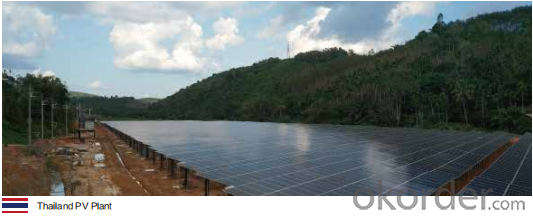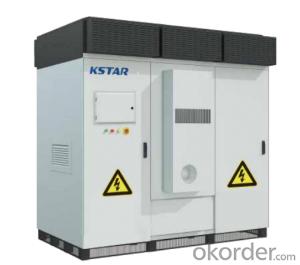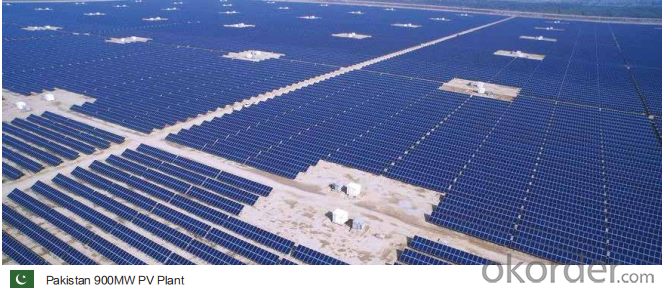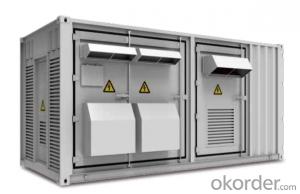8 Kw Solar Inverter DC1500V Container Solution GSM2500D / GSM3125D
- Loading Port:
- China main port
- Payment Terms:
- TT OR LC
- Min Order Qty:
- 50 pc
- Supply Capability:
- 15000 pc/month
OKorder Service Pledge
OKorder Financial Service
You Might Also Like
Specification
Product Description:
★Max. PV voltage up to 1500V Max. 24 DC inputs
★IP55 outdoor protection Modular design for Easy maintenance
★Max. DC/AC ratio up to 1.8 Full power output under 55℃
★AGC/AVC Night SVG function LVRT/HVRT/FRT function
Technical Specifications:


FAQ:
Q:How the output voltage of the PV inverter and the grid-connected voltage are determined
Inverter is the DC power (battery, battery) into alternating current (usually 220V, 50Hz sine wave). It consists of inverter bridge, control logic and filter circuit. Widely used in air conditioning, home theater, electric wheel, power tools, sewing machines, DVD, VCD, computer, TV, washing machine, range hood, refrigerator, video recorders, massage, fan, lighting and so on. In foreign countries
Q:Installation and maintenance of photovoltaic grid - connected inverter
only when the local power sector permission by the professional and technical personnel to complete all the electrical connection before the inverter can be connected.
Q:What is the difference between a PV grid-connected inverter and an off-grid inverter?
Off-grid inverter is equivalent to their own to establish an independent small power grid, mainly to control their own voltage, is a voltage source.
Q:After the PV inverter, how to achieve the same period before the network?
Solar panel simulator: with MPPT function, simulated morning, noon, afternoon, evening, rainy weather, solar panels produced under different conditions in different voltages.
Q:Is the PV inverter a current source or a voltage source?
According to the waveform modulation method can be divided into square wave inverter, stepped wave inverter, sine wave inverter and modular three-phase inverter.
Q:Photovoltaic grid-connected inverter without DC emc how will happen
Solar photovoltaic power generation technology is the use of solar cells, the photovoltaic effect of semiconductor materials, solar radiation can be directly converted into a new type of power generation system, solar energy is a radiant energy, solar power means --- to direct conversion of sunlight Into electricity,
Q:What is the difference between low voltage grid connection and medium voltage grid connection?
For photovoltaic power plants when the power system accidents or disturbances caused by photovoltaic power plant grid voltage drop, in a certain voltage drop range and time interval, the photovoltaic power plant can ensure that non-off-line continuous operation.
Q:Is the grid side of the grid and the inverter?
The grid load side of the grid is the grid. The inverter is an important part of the PV grid-connected system and can not be regarded as an external load. Photovoltaic power generation system is included in both grid and off-grid.
Q:PV grid-connected inverter and independent inverter in the control of what is the difference
The independent inverter in the output voltage phase amplitude of the frequency control is initially set good. Independent inverter, you should refer to off-grid inverter, do not need to consider the grid situation.
Product Images:







Production Process Photos:





- Q: Can a solar inverter be used in standalone power systems?
- Yes, a solar inverter can be used in standalone power systems. Standalone power systems, also known as off-grid systems, are not connected to the traditional electrical grid. In such systems, solar inverters convert the direct current (DC) generated by solar panels into alternating current (AC) that can be used to power various electrical devices and appliances. The solar inverter is an essential component in standalone power systems as it enables the efficient utilization of solar energy for off-grid applications.
- Q: What are the potential risks of overheating a solar inverter?
- The potential risks of overheating a solar inverter include reduced efficiency and performance, increased wear and tear on components, shortened lifespan of the inverter, potential damage to internal circuitry, and even the risk of fire.
- Q: How does a solar inverter handle grid disturbances (voltage sags, swells, flickers)?
- A solar inverter handles grid disturbances such as voltage sags, swells, and flickers by employing various protective mechanisms. It actively monitors the grid's voltage levels and reacts accordingly to maintain a stable and reliable power output. During voltage sags, the inverter adjusts its output voltage to compensate for the drop and ensure a consistent energy supply. In the case of swells, the inverter quickly detects the excessive voltage and disconnects from the grid to prevent any damage. Flickers, caused by rapid voltage fluctuations, are minimized by the inverter's ability to rapidly respond and stabilize the power output. Overall, solar inverters play a crucial role in mitigating grid disturbances and safeguarding the solar power system's performance and longevity.
- Q: How does a solar inverter handle voltage transients?
- A solar inverter handles voltage transients by regulating and stabilizing the incoming DC voltage from the solar panels, and converting it into a steady AC voltage suitable for use in the electrical grid or for powering appliances. It uses various electronic components and control algorithms to monitor and adjust the voltage levels, ensuring that any sudden changes or fluctuations in the input voltage are smoothed out and the output remains consistent and within acceptable limits.
- Q: How is the output voltage and frequency of a solar inverter regulated?
- The output voltage and frequency of a solar inverter are regulated through a combination of control algorithms and power electronics. These control algorithms constantly monitor and adjust the voltage and frequency based on the energy generated by the solar panels and the power requirements of the connected load. The power electronics, such as voltage regulators and frequency converters, ensure that the output voltage and frequency remain within the desired range. This regulation is crucial to provide stable and consistent power to the electrical grid or the connected devices.
- Q: Can a solar inverter be used for off-grid applications?
- Yes, a solar inverter can be used for off-grid applications. Off-grid systems typically rely on solar panels to generate electricity, and a solar inverter is essential in converting the direct current (DC) generated by the panels into alternating current (AC) which can be used to power various appliances and devices. The inverter also manages the flow of electricity, ensures system stability, and may include features like battery charging and energy storage capabilities, making it suitable for off-grid applications where no grid connection is available.
- Q: What is the role of a power control feature in a solar inverter?
- The role of a power control feature in a solar inverter is to efficiently manage and optimize the power output generated by the solar panels. It helps regulate the flow of electricity, maintaining a stable voltage and frequency, while also ensuring that the maximum power point tracking (MPPT) is achieved. This feature allows for better performance, increased energy production, and the ability to adapt to changing sunlight conditions, ultimately maximizing the overall efficiency of the solar inverter system.
- Q: What are the key factors affecting the efficiency of a solar inverter?
- The key factors affecting the efficiency of a solar inverter include the quality and design of the inverter itself, the type and quality of the solar panels used, the temperature at which the inverter operates, and the level of shading or obstruction on the solar panels. Additionally, the efficiency can also be influenced by the electrical load connected to the inverter and the overall system design and installation.
- Q: Can a solar inverter be used with a net metering system?
- Yes, a solar inverter can be used with a net metering system. A solar inverter is an essential component of a solar power system as it converts the direct current (DC) generated by solar panels into usable alternating current (AC) electricity. Net metering allows for the excess electricity produced by the solar panels to be fed back into the grid, resulting in credit or compensation from the utility company. The solar inverter facilitates this process by ensuring that the electricity generated by the solar panels is synchronized with the grid, allowing for seamless integration and net metering.
- Q: How does a solar inverter handle voltage sags and swells?
- A solar inverter handles voltage sags and swells by continuously monitoring the voltage levels of the grid. When it detects a voltage sag (a drop in voltage below a certain threshold) or a voltage swell (a sudden increase in voltage above a certain threshold), the inverter adjusts its operation to compensate for the deviation. It can either decrease or increase the power output to ensure that the electricity being fed into the grid remains within acceptable voltage limits. This helps to stabilize the grid and protect connected devices from potential damage.
Send your message to us
8 Kw Solar Inverter DC1500V Container Solution GSM2500D / GSM3125D
- Loading Port:
- China main port
- Payment Terms:
- TT OR LC
- Min Order Qty:
- 50 pc
- Supply Capability:
- 15000 pc/month
OKorder Service Pledge
OKorder Financial Service
Similar products
Hot products
Hot Searches
Related keywords
































